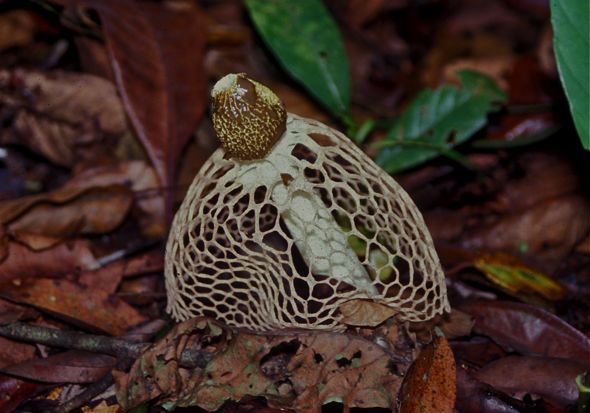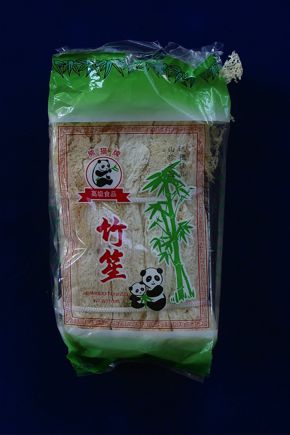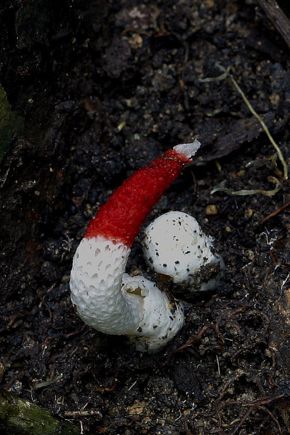Appeal to Singapore’s Land Transport Authority to re-route the proposed cross-island MRT line away from the MacRitchie forest – sign the petition HERE.
One of the most beautiful mushroom one can encounter in the MacRitchie forest is the fruiting body of the Basket Stinkhorn (Dictyophora indusiata) (above). The stout stalk ends in a bulbous head. And hanging from the lower edge of this head is a net-like white veil or skirt that flares out to reach the ground. A putrid odour emits from the olive-green to brown spore slime covering the mushroom head. The smell attracts flies and carrion beetles that arrive to feed on the slime and in the process help spread the spores.
This attractive fruiting body does not last long. Before noon the stalk collapses and the spore slime slowly drips off and the entire structure rots away. Butterflies have been observed feeding on the slime. The image above shows the Malay Viscount (Tanaecia pelea pelea) feeding on the rotting Basket Stinkhorn while the that below shows the Banded Swallowtail (Papilio demolion demolion) feeding on its bulbous head (below).
Because of the unusual shape of the fruiting body, these stinkhorns are collected for its supposedly medicinal value. It is claimed that it contains an active agent that can reduce blood pressure and body fat. However, many believe in its aphrodisiac properties because of its phallic shape. The Panda Brand “Bamboo Fungus” consists of dried stinkhorns sold as a Chinese medicinal product (below left).
The Dog Stinkhorn (Mutinus elegans), also known as Headless Stinkhorn and Devil’s Dipstick, develops a slender, straight or curved stalk tapering to a pointed tip (above right). The upper half is bright red to reddish orange. As in the case of stinkhorns, it gives off a foul odour, The spore mass is found on the upper third of the stalk, appearing greenish-brown. Butterflies would be attracted to the spore mass but images are not available.
Credit: Khew Sin Khoon (Banded Swallowtail on a Basket Stinkhorn), YC Wee (all other images).
Earlier Posts:
1. Saving MacRitchie forest: A youngster’s view LINK
2: Introduction LINK
3: Flying Lemur LINK
4: Mammals LINK
5. Fragile frogs and tender tadpoles LINK
6. Refuge for reptiles LINK
7. Eco-performance LINK
8. You can’t see the wood from the trees LINK
9. Sanctuary for spiders LINK
10. Chained to our roots LINK
11. Plants LINK
12. Birds and their status.LINK
13. Mushrooms LINK
14. Butterflies, jewels of the forest LINK
15. A pangolin’s plea LINK




![BandedSwallowtail-Dictyophora indusiata [KhewSinKhoon]](https://besgroup.org/wp-content/uploads/BandedSwallowtail-Dictyophora-indusiata-KhewSinKhoon.jpg)









8 Responses
Yes, this “Bamboo Fungus” can make a delicious soup.
Thanks for the offer Aly. We will KIV the offer for the moment.